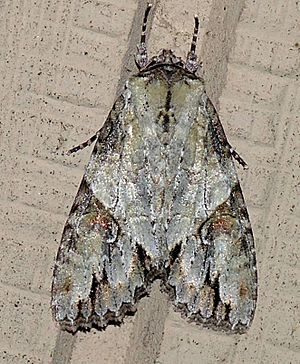Fluid arches facts for kids
Quick facts for kids Fluid arches |
|
|---|---|
 |
|
| Scientific classification | |
| Kingdom: | |
| Phylum: | |
| Class: | |
| Order: | |
| Family: | |
| Genus: |
Morrisonia
|
| Species: |
M. latex
|
| Binomial name | |
| Morrisonia latex Guenée, 1852
|
|
| Synonyms | |
|
|
The Fluid Arches moth (scientific name: Morrisonia latex) is a fascinating insect. It belongs to a large group of moths called the Noctuidae family. This moth was first officially described in 1852 by a scientist named Achille Guenée. You can find the Fluid Arches moth across a wide area of North America. It lives from Nova Scotia in the east, down to South Carolina, and west to Arkansas and Manitoba.
About the Fluid Arches Moth
The Fluid Arches moth gets its common name from the patterns on its wings. Like all moths, it is an Insect and part of the Lepidoptera order. This order includes both moths and butterflies. Moths are known for their fuzzy bodies and often fly at night.
When Does it Fly?
The Fluid Arches moth is active for a few months each year. You can usually spot them flying between May and July. The exact time depends on where they live. For example, moths in warmer southern areas might appear earlier than those in cooler northern regions.
What Do Fluid Arches Moth Larvae Eat?
The young stage of a moth is called a larva, or caterpillar. Fluid Arches moth caterpillars are quite picky eaters! They mostly munch on the leaves of various trees. These trees are common in the areas where the moths live.
Here are some of the trees that Fluid Arches moth larvae like to eat:
- Red maple (Acer rubrum)
- Sugar maple (Acer saccharum)
- Acer saccharinum
- Acer nigrum
- Black cherry (Prunus serotina)
- Sweet birch (Betula lenta)
- River birch (Betula nigra)
- Yellow birch (Betula alleghaniensis)
- Paper birch (Betula papyrifera)
- American elm (Ulmus americana)
- Black gum (Nyssa sylvatica)
- White oak (Quercus alba)
- Northern red oak (Quercus rubra)
- Chestnut oak (Quercus montana)
- Black oak (Quercus velutina)
- Sassafras (Sassafras albidum)

